The study of endocrine glands and their hormones is called "endocrinology". All hormones are not always proteins. Based on the components, hormones are classified into four types.
1. Protein or peptide hormones:
These are made up of proteins or peptides e.g. hormones of hypothalamus, pituitary, parathyroid, pancreas and relaxin of ovary.
2. Steroid hormones:
These are made up of steroids e.g. hormones of adrenal cortex, ovaries and testes.
The names of steroid hormones contain the word "stero". These stimulate the body organs highly. Hence synthetic steroids are being misused by athelets.
3. Aminoacid derivatives or biogenic amines:
These hormones are derived from aminoacids e.g. melatonin and adrenalin of medulla.
4. lodinated aminoacid:
E.g. thyroxine.
DIFFERENT TYPES OF ENDOCRINE GLANDS
- Pineal body
- Pituitary
- Thymus
- Thyroid
- Parathyroid
- Adrenal
- Pancreas
- Gonads
- Mucosa of alimentary canal
The location, structure and functions of the endocrine glands are shown in Figure 525.1.
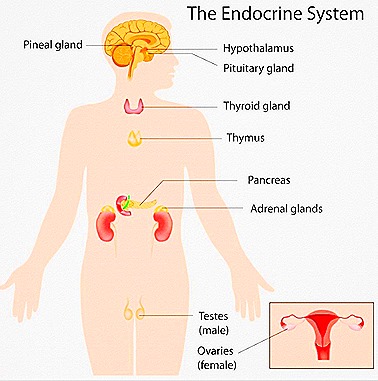
1. PINEAL BODY
It is attached to the dorsal wall of diencephalon by pineal stalk. Based on its position it is also called "epiphysis" [Epi-upon; physis-brain].
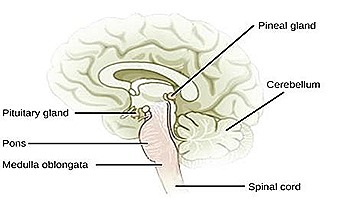
Till recently, it was beleived that the pineal gland found in man was a vestigeal organ. It is now known that the pineal body secretes melatonin, which is an antigonadial as it may delay the sexual development.
2. PITUITARY GLAND
The pituitary is a small pea-shaped gland situated below the hypothalamus [ventral wall of diencephalon]. It is connected to the hypothalamus by a stalk called "infundibulum". Based on the position the gland is also called "hypophysis" [hypo-below; physis-brain]. Until recently, the pituitary gland was considered to be the "master or chief gland of endocrine system". It is now known that the pituitary itself depends upon the hormones of hypothalamus.
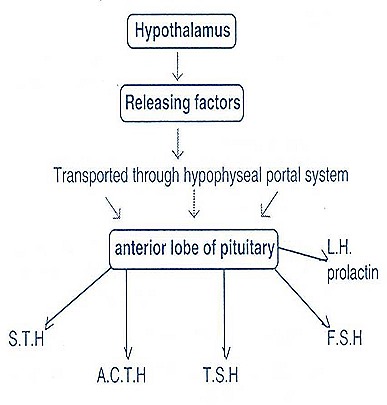
The hypothalamus secretes many hormones called "neurohormones" or "releasing factors". These are transported to the anterior lobe of pituitary through the "hypophyseal portal system". The releasing factors stimulate the pituitary to secrete its hormones.
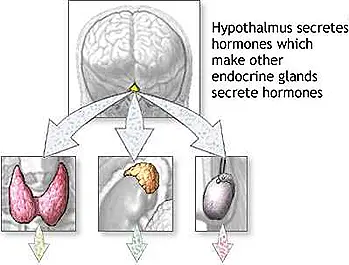
The pituitary is divided into 3 parts viz., anterior, intermediate and posterior. The anterior and middle parts of pituitary together called "adenohypophysis". Whereas the posterior part is called "neurohypophysis".
A. Anterior lobe of Pituitary:
It secretes six hormones, namely
- A.C.T.H,
- T.S.H,
- S.T.H,
- F.S.H,
- L.H and
- Prolactin.
A.C.T.H [Adreno cortico tropic hormone]:
It stimulates the cortex of adrenal gland to secrete gluco, mineral and sex corticoids.
T.S.H [Thyroid stimulating hormone] or T.T.H [Thyro tropic hormone]:
It stimulates the thyroid gland to secrete thyroxine.
S.T.H [Somato tropic hormone] or G.H. [growth hormone]:
It stimulates the growth tissues especially long bones and muscles. The growth hormone is probably the only anterior pituitary hormone which does not stimulate any other endocrine gland.
In man, over secretion or hyper pituitarism of S.T.H, in child hood leads to "gigantism". In the adults over secretion leads to elongation of long bones of limbs and lower jaw and a gorilla like appearance ["Acromegaly"]. Failure of G.H from an early age makes the child dwarf ["Dwarfism"].
G.T.H [Gonado tropic hormone ] or gonadotropins:
These are three types, (1) F.S.H, (2) L.H., and (3) Prolactin [L.T.H].
F.S.H [Follicle stimulating hormone]: It stimulates the testes in the male to produce sperms and the ovaries in the female to produce ova. In female human being F.S.H also stimulates ovaries to secrete female sex hormones called "estrogens".
L.H [Lutenising hormone]: It stimulates ovary to secrete female sex hormone called "progesterone". It is absent in frog.
I.C.S.H [ Interstitial cell stimulating hormone] or L.H.: It stimulates the testis to secrete the male sex hormones called "testosterones or androgens".
Prolactin or L.T.H [Luteo tropic hormone ]: In female human being prolactin stimulates the mammary glands to secrete milk after the birth of the child.
B. Intermediate lobe of Pituitary:
It secretes a hormone called intermedin or "M.S.H" [melanocyte stimulating hormone"]. When ever M.S.H reaches melanocytes, then the melanocytes synthesize melanin.
C. Posterior lobe or neurohypophysis of Pituitary:
The posterior lobe consists of the axons of neurons of hypothalamus. The two hormones oxytocin and A.D.H. (vasopressin) are formed in hypothalamus, which are stored in posterior lobe. Whenever the body requires, the oxytocin and A.D.H. are released into the blood from the posterior lobe.
- "Oxytocin" stimulates the contraction of uterus in pregnant woman during the child birth [parturition].
- A.D.H [Anti diuretic hormone] increases the reabsorption of HzO in the distal convoluted tubule of kidney. Defeciency of A.D.H increases the urine flow and causes the disease called "diabetes insipidus" [Diabete-urine, insipid -tasteless]. Hence the urine is highly diluted. Over secretion of A.D.H. increases the absorption of H20. Hence the urine is highly concentrated.
3. THYMUS GLANDS
These are a pair of small, oval reddish bodies lying one on each side just below the tympanum. As the age advances, the glands reduce in size. It secretes a hormone called "Thymosin". It differentiates the T lymphocytes.
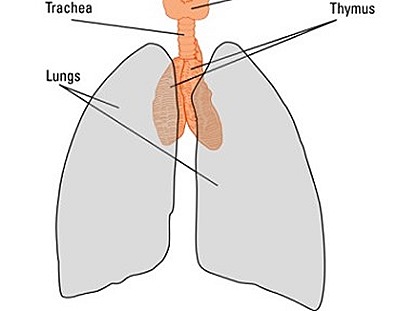
4. THYROID GLAND
Thyroid is a bilobed gland. The two lobes lie on either sides of larynx.The two lobes are connected by isthamus. They secrete a hormone called "Thyroxine". It is rich "iodinated hormone". It contains an aminoacid called "Thyroxine". Thyroxine increases the metabolic activities. Hence it maintains B.M.R [Basal metabolic Rate]. The thyroxine is essential for metamorphosis in frog. It is also essential for tissue differentiation.
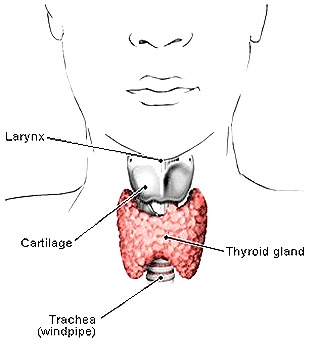
If the thyroid glands are removed in tadpole larva of frog it fails to undergo metamorphosis. When such thyroid free tadpole larva is fed with thyroid glands, it undergoes metamorphosis. If normal young tad poles are fed with thyroxine, they metamorphose into frogs prematurely [the normal period of metamorphosis is reduced].
In human beings, failure of thyroid secretion in child hood leads to mental retardation. This disease is called "cretinism". Defeciency of thyroid secretion in adults produces "Myxedema". Hyper thyroidsm leads to "exophthalmic goiter" or Grave's disease. Less secretion in the aged persons leads to the swelling of lobes of thyroid. The disease is called simple goitre.
5. PARATHYROID GLANDS
These are four small glands situated very close to the thyroid glands. These secrete calcium hormone called "parathyroid hormone". It regulates the calcium level in the blood.
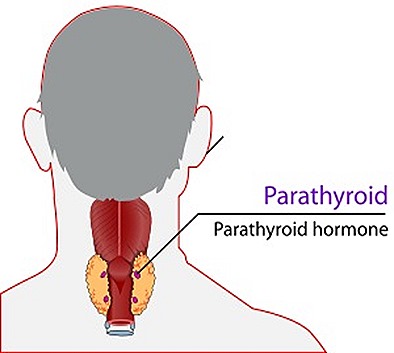
6. ADRENAL GLANDS
There are two adrenal or supra renal glands situated longitudinally on the ventral surface of kidneys. These are orange colored glands. The outer part of each gland is called "cortex" and the inner part is called "medulla". The cortex of adrenal gland is stimulated by A.C.T.H. of pituitary. But medulla is not stimulated by pituitary gland. The cortex secretes gluco corticoids, mineral corticoids and sex corticoids.
Glucocorticoids:
These increase blood glucose level by the synthesis of glucose from proteins. It is called "gluconeogenesis". Blood glucose level is also increased by the convertion of glycogen to glucose. It is called "glycogenolysis".
Mineral corticoids:
These maintain water and salt balance.
Sex corticoids:
These stimulate the development of secondary sexual characters.
Excessive secretion of sex corticoids in women causes the development of male secondary sexual characters like "beard" and "moustaches". The disease is called "virilism". Defeciency of mineral corticoids leads to bronze pigmentation in skin. The disease is called "Addison's disease".
The central part or medulla of adrenal gland secretes two amines, "epinephrine" [adrenaline] and "norepinephrine" [noradrenaline]. These regulate the blood pressure, heart beat, respiration, contractions and relaxations of smooth muscles. The epinephrine prepares the individual for meeting stress or emergency. Hence the adrenal medulla is considered as the gland for "fight, fright and flight".
7. PANCREAS
It is a creamy white colored gland lies between the stomach and duodenum. The gland consists of both "exocrine" and "endocrine" parts. Hence the pancreas is described as "exo and endo crine gland". The exocrine part secretes the digestive juice called pancreatic juice. The endocrine part consists of groups of prism shaped cells called "islets of Langerhans", which lie between the exocrine lobules. The islets of langer hans are of two types, α [alpha] - cells and inner β [beta] - cells. These α and β cells produce two types of hormones.
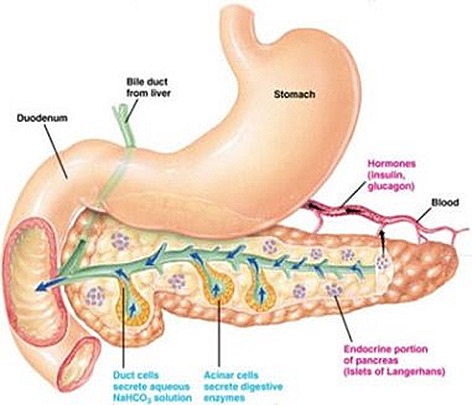
- α-cells secrete a hormone called "glucagon". It increases the sugar, glucose level in the blood by glycogenolysis [convertion of glycogen into glucose]. Hence glucagon is described as "hyper glycemic hormone".
- β-cells secrete a hormone called "insulin", [covertion of glucose into glycogen]. So, it lowers the sugar level in the blood. It is described as "hypoglycemic" hormone.
The glucagon and insulin have opposite actions with one another.
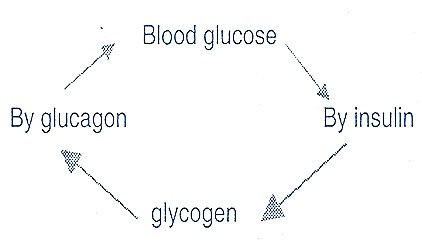
In man the defeciency of insulin causes a disease called "diabetes mellitus " [sugar disease]. Such patient consists of excess sugar in the blood and eliminates sugar through urine ["glycosuria"].
8. GONADS
The gonads secrete hormones called "Sex hormones". These are two types, male and female hormones. The gonads are stimulated by pituitary gonadotropins to secrete the hormones.
In male the endocrinal cells of testes are called "Leydig cells". These are the interstitial cells present between the seminiferous tubules. The leydig cells secrete male hormones called "testosterohes" or "androgens". These are responsible for the development of secondary sexual characters like the formation of beard, moustachs and change in the voice.
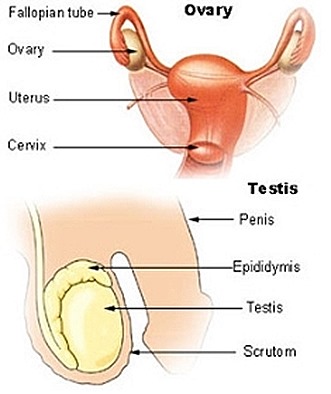
In female, the follicle cells around the ovum act as the endocrinal cells. These cells secrete female sex hormones called "estrogens" and progesterons. These change the uterus for the implantation of embryo.
9. GASTROINTESTINAL HORMONES
The mucosa layer of stomach and duodenum acts as endocrinal part. It is made up of columnar epithelium. The mucosa secretes many hormones, which play an important role in the release of digestive juices. The hormones are
Gastrin:
It is secreted by the mucosa of stomach. The gastrin stimulates the gastric glands to secrete gastric juice.
Entero gastrone:
It is secreted by the mucosa of duodenum. When the chyme enters the duodenum, the entero gastrone is released into the blood. It reaches the stomach through the blood. Then it inhibits the secretion of gastric juice.
Secretin and Pancreozymin:
These are also secreted by duodenum. These stimulate the pancreas to secrete digestive juice.
Cholecystokinin:
It is also secreted by duodenum. It stimulates the contraction of gall bladder. Then only the bile juice is released into the duodenum through bile duct.
Entero crinin:
It is also secreted by duodenum. It activates the intestinal glands to secrete intestinal juice.
The hormones of alimentary canal regulate the activities of digestive glands and maintain the "gastro intestinal co-ordination".
PHEROMONES
Pheromones are the ectohormones. These are released into the atmosphere to attract the opposite sex or to communicate the other individuals of its own species. For example, formic acid is the ectohormone released by red ants. If one red ant identifies the place of food, such ant releases formic acid.
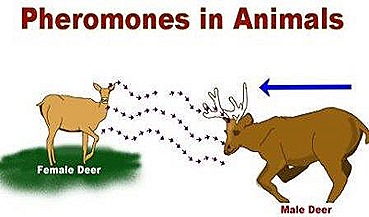
This formic acid becomes the communication to the other red ants. Then the red ants follow the same path as shown by first ant. Bombikiol is the pheromone, released from silk worm mouth.